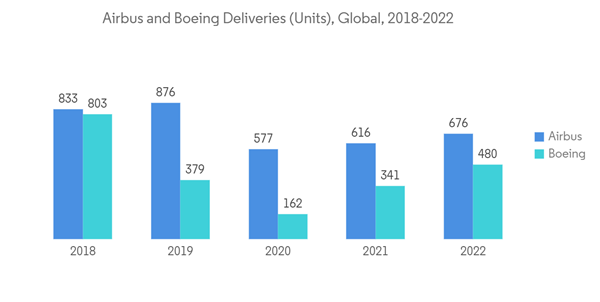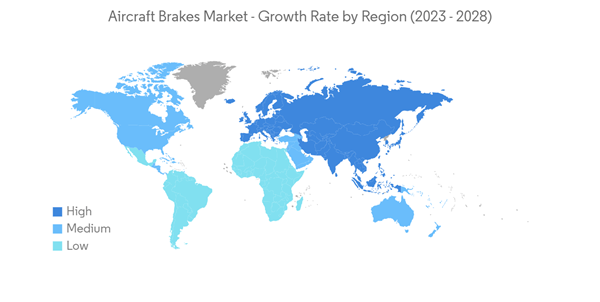The Aircraft Brakes Market size is estimated at USD 9.83 billion in 2024, and is expected to reach USD 12.65 billion by 2029, growing at a CAGR of 5.16% during the forecast period (2024-2029).
With high brand values and long-term contracts with aircraft OEMs, these prominent players dominate the market, making it difficult for new players to capitalize on this landscape. The investments by the companies in electric brake technology, which is currently in its initial stage, are also expected to help them maintain prominent positions, during the transition from carbon brakes to electric brakes, in the near future.
This product will be delivered within 2 business days.
Key Highlights
- The aviation sector faced unmatched challenges due to the COVID-19 pandemic. Supply chain disruptions brought by the pandemic and labor shortages hindered the market growth during the pandemic. Also, key aircraft OEMs such as Airbus and Boeing halted production due to employee safety concerns and government regulations that hamper the market growth. The market showcased a strong recovery from 2021 due to increased demand for new aircraft and rising spending on advanced aircraft brakes.
- The procurement of newer generation aircraft in the commercial and military sectors is one of the major reasons for the development of the aircraft brakes market. With increasing emphasis on the reduction of the weight of aircraft and with the concept of more electric aircraft, new lightweight brakes are being developed (like electric brakes).
- Aircraft brake systems are essential components of all aircraft that allow the aircraft to land safely and quickly. Growing demand for new commercial and military aircraft and rising spending on the development of advanced braking systems propel the demand for aircraft brakes. Technological advancements in the aircraft braking system and the introduction of advanced brake discs drive the growth of the market.
Aircraft Brakes Market Trends
The Commercial Segment is Projected to Show Highest Growth During the Forecast Period
- The commercial segment is anticipated to show significant growth in the aircraft brakes market during the forecast period. The growth is attributed to the increase in aircraft orders and deliveries to cater to the growing passenger traffic around the world. Currently, carbon brakes are very much popular in the aviation industry, with most narrow-body, wide-body, and regional jets using them due to their lightweight, as compared to steel brakes, and more mean time between repairs (MTBR).
- Safran Landing Systems' carbon brakes feature on the Airbus A320ceo/neo and A350 family, Boeing B737NG/MAX, and the B787 Dreamliner. Increased efficiency and durability are the major benefits of braking systems. According to Safran, carbon brakes equipped with B737 can conduct 2,200 landings between overhauls. It also offers 2,500 landings on A320neo family aircraft and 2,000 landings for those on the A350.
- However, in recent years, the commercial aviation sector has been moving toward more electric architecture, with the main aim of reducing weight and lowering fuel costs. This shift is supporting the adoption of the new electric brake technology that comes with low weight and improved performance, as well as ease of maintenance. The airlines tend to use electric brakes, as they help in cutting down fuel and maintenance costs. The trend in commercial aircraft technology will be a major factor in supporting the growth of this segment during the forecast period.
Asia-Pacific to Experience the Highest Growth During the Forecast Period
- The Asia-Pacific will showcase the highest growth in the aircraft brakes market during the forecast period. The growth is due to increasing air traffic, the development of new airports, and rising expenditure on the procurement of commercial and military aircraft. According to the International Air Transport Association (IATA), China would become the largest aviation market in terms of seating capacity in mid-2020, and India will surpass the UK and become the third-largest aviation market in the world by 2024. Furthermore, Airbus, an aircraft OEM, forecasts that the Asia-Pacific region will need over 17,600 new aircraft by 2040.
- In addition to the procurements and orders, the region is involved in the development of new aircraft, like the Advanced Medium Combat Aircraft (AMCA) program for India, KF-X for Korea and Indonesia, and the COMAC C919 for China. The development of such advanced aircraft will require newer types of brakes, which will improve performance. The ongoing procurements of aircraft, along with the increasing manufacturing capabilities, will boost the growth of the region during the forecast period. For instance, in August 2022, RUAG Australia signed an agreement with Honeywell International Inc. to become a maintenance, repair, and overhaul (MRO) Authorised Service Centre for the F-35 Joint Strike Fighter Wheels and Brakes program in the Asia-Pacific (APAC) region.
Aircraft Brakes Industry Overview
The aircraft brakes market is consolidated in nature, with a presence of few players holding significant shares in the market. The prominent players in the market are RTX Corporation, Safran, Crane Aerospace & Electronics, Meggitt PLC, and Honeywell International Inc. These are firms that supply brakes and braking systems to most of the aircraft in the military, commercial, and general aviation sectors.With high brand values and long-term contracts with aircraft OEMs, these prominent players dominate the market, making it difficult for new players to capitalize on this landscape. The investments by the companies in electric brake technology, which is currently in its initial stage, are also expected to help them maintain prominent positions, during the transition from carbon brakes to electric brakes, in the near future.
Additional Benefits:
- The market estimate (ME) sheet in Excel format
- 3 months of analyst support
This product will be delivered within 2 business days.
Table of Contents
1 INTRODUCTION
4 MARKET DYNAMICS
5 MARKET SEGMENTATION
6 COMPETITIVE LANDSCAPE
Companies Mentioned (Partial List)
A selection of companies mentioned in this report includes, but is not limited to:
- Safran
- Meggitt PLC
- Honeywell International Inc.
- RTX Corporation
- Crane Aerospace & Electronics
- Beringer Aero
- Advent Aircraft Systems Inc.
- Tactair
- RAPCO, Inc.
- Matco Aircraft Landing Systems
- The Carlyle Johnson Machine Company, LLC
Methodology

LOADING...










